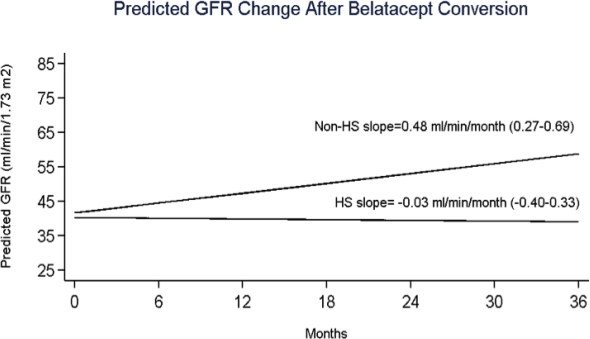Clinical Outcomes of Conversion from Calcineurin Inhibitor to Belatacept-Based Immunosuppression in Highly Sensitized Kidney Transplant Recipients
Cedars Sinai Medical Center, Los Angeles.
Meeting: 2018 American Transplant Congress
Abstract number: 119
Keywords: Calcineurin, Co-stimulation, Efficacy, Sensitization
Session Information
Session Name: Concurrent Session: Kidney Immunosuppression: Co-Stimulation Based Regimens
Session Type: Concurrent Session
Date: Sunday, June 3, 2018
Session Time: 4:30pm-6:00pm
 Presentation Time: 4:54pm-5:06pm
Presentation Time: 4:54pm-5:06pm
Location: Room 6C
Introduction:Efficacy of belatacept when converted from calcineurin inhibitors (CNI) in high immunologic risk patients has not been established. We examined the impact of HLA-sensitization on outcomes in patients converted from CNI to belatacept at our center.
Methods: One hundred and eight adult kidney transplant recipients converted from CNI to belatacept between 7/1/12 to 9/30/17 were included. The outcomes of acute rejection, graft and patient survival, and eGFR slope post-conversion were compared between the highly-sensitized (HS) (cPRA≥30% or re-transplant) and non-HS (cPRA<30%) patients.
Results: The study cohort consisted of 25 HS (median class I PRA 54, IQR 0,88; class II PRA 75 IQR:0,93) and 83 non-HS patients. Median time to conversion was 404 days (IQR:116,1916) in HS vs 293 days (IQR:68,1538) in non-HS group. There was no difference in the proportion of patients converted due to graft dysfunction (88% vs 85%, p=0.76) or CNI side effects (12% vs 15%) in HS vs non-HS groups. Median follow-up post-conversion was 326 days (IQR: 197, 771). There was a higher incidence of acute rejection in HS group, but no difference in graft or patient survival post conversion.  All rejections were cell-mediated and most occurred in patients converted early (<6 months) after transplant (HS-4/4; non-HS-5/6). On average, eGFR slope improved post-conversion in non-HS, but exhibited a slight decline in HS recipients.
All rejections were cell-mediated and most occurred in patients converted early (<6 months) after transplant (HS-4/4; non-HS-5/6). On average, eGFR slope improved post-conversion in non-HS, but exhibited a slight decline in HS recipients. 
Conclusion: There was a higher incidence of acute rejection after belatacept conversion in HS vs non-HS patients, primarily in patients converted early after transplant. Conversion from CNI to belatacept may allow for better renal function but should be done cautiously in high immunologic risk patients. Optimal timing of CNI withdrawal in these patients needs further investigation.
CITATION INFORMATION: Sethi S., Choi J., Vo A., Peng A., Lim K., Najjar R., Jordan S., Huang E. Clinical Outcomes of Conversion from Calcineurin Inhibitor to Belatacept-Based Immunosuppression in Highly Sensitized Kidney Transplant Recipients Am J Transplant. 2017;17 (suppl 3).
To cite this abstract in AMA style:
Sethi S, Choi J, Vo A, Peng A, Lim K, Najjar R, Jordan S, Huang E. Clinical Outcomes of Conversion from Calcineurin Inhibitor to Belatacept-Based Immunosuppression in Highly Sensitized Kidney Transplant Recipients [abstract]. https://atcmeetingabstracts.com/abstract/clinical-outcomes-of-conversion-from-calcineurin-inhibitor-to-belatacept-based-immunosuppression-in-highly-sensitized-kidney-transplant-recipients/. Accessed December 7, 2025.« Back to 2018 American Transplant Congress
